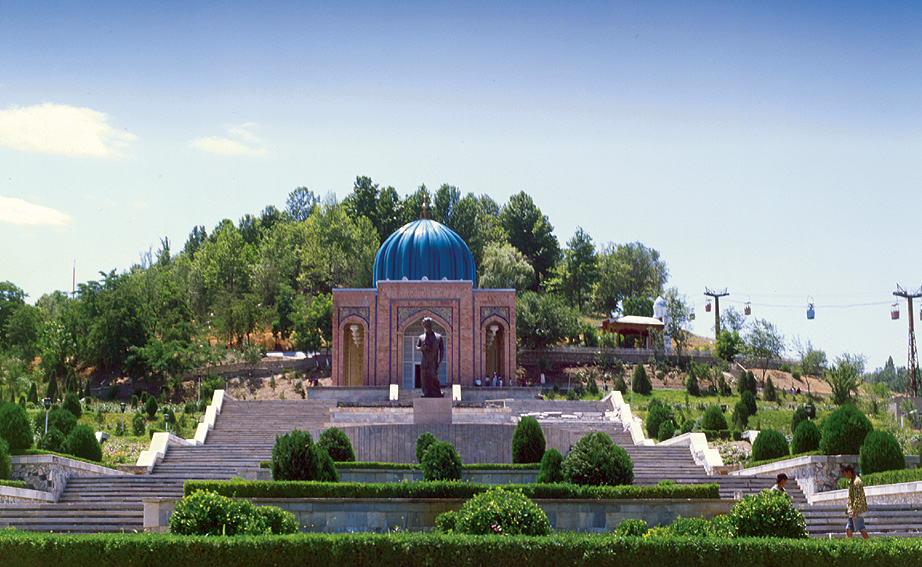Andijan is a city and administrative center in far eastern Uzbekistan
Andijan
Andijan is a city and administrative center in far eastern Uzbekistan in Andijan province, is situated in the Southeast of the Ferghana Valley and is surrounded by high mountains and hills. Andijan is about 475 km east of Tashkent, and about 45 km west of Osh, Kyrgyzstan. Andijan is a center of oil production and has a few oil refineries. Cotton growing and processing remain the dominant economic activities.
The history of the city goes back to the 9th century AD. In ancient times the Great Silk Road passed through this town, which was known as the eastern gate of the Ferghana Valley. In the 10th century Andijan was the part of the Samanids Empire. In 1483 Zaheruddin Babur was born here, and Andijan became the capital of the Ferghana State and its major Silk Road trading center. Later Babur had to go to Afghanistan and he ruled Kabul for two decades, then in 1526 he marched into Delhi and founded the Mughal Empire in India. The dynasty of the Babur's had ruled India for more than 300 years.
In the 18th and 19th cc. Andijan was a part of the Kokand khanate (state) was centered in present-day Kokand. In 1876 Andijan was captured by Russian forces.
The Fergana Valley's last local rebellion against the rule of the Russian Tsar took place at Andijan in 1898. An earthquake destroyed most of the old part of the city in 1902, killing more than 4000 people.

The Babur Literary Museum - is situated behind the bazaar, occupying the site of the royal apartments, where Babur lived and studied in Ark-Ichi, the town's citadel that exists no more. The museum opened in 1989 on the site of his residence, in celebration of the 460th year of publication of his autobiography entitled Baburname, published in English as the Memoirs of Babur. Andijan also has teacher-training, medical, and cotton-growing institutes.
Historical and architectural monuments of Andijan
Juma Mosque and Madrassah - built in the 19th century, is said to be the only building to survive the 1902 earthquake;
Home of Akhmadbek-hadja (early 20thc.)
Education
There are four higher education institutions in Andijan City. The Andijan Medical Institute is the largest of the four. The city is also home to four colleges, one academic lyceum, 21 vocational schools, 47 secondary schools, three music and art schools, nine sports schools, and 86 kindergartens
Economy
Andijan has been an important craft and trade center in the Fergana Valley since the 15th century. After annexation by the Russians in 1876, the economy of the city started to grow significantly. Several industrial plants were built in Andijan after the city was connected with Russia with a railway line in 1889. Several hospitals, pharmacies, banks, and printing houses were established in the city during that period. After Soviet rule was established in late December 1917, both light and heavy industries developed significantly. Andijan became the first city in Uzbekistan to be fully supplied with natural gas.

Andijan remains an important industrial city in independent Uzbekistan. There are 48 large industrial plants and about 3,000 small and medium enterprises in the city.Manufactured goods produced in the city include chemicals, domestic appliances, electronics, foodstuffs, furniture, plows, pumps, shoes, spare parts for farming machines, various engineering tools, and wheelchairs. Andijan is also home to over 50 international companies,[citation needed] five of which produce spare parts for GM Uzbekistan.
Early and recent history
Andijan is one of the oldest cities in the Fergana Valley. In some parts of the city, archeologists have found items dating back to the 7th and 8th centuries.Historically, Andijan was an important city on the Silk Road.
The city is perhaps best known as the birthplace of Babur who, following a series of setbacks, finally succeeded in laying the basis for the Mughal dynasty in the Indian Subcontinent and became the first Mughal emperor.During the reign of the Timurids, especially Babur, Andijan was a large and important city in the region. During that period, art and culture flourished in the city.
After the formation of the Khanate of Kokand in the 18th century, the capital was moved from Andijan to Kokand. In the mid-19th century, the Russian Empire began occupying the area of present-day Central Asia. In 1876, the Russians conquered the Khanate of Kokand and the city of Andijan along with it.
Andijan was the center and flashpoint of the Andijan Uprising of 1898 in which the followers of Sufi leader Madali Ishan attacked the Russian barracks in the city, killing 22 and injuring 16-20 more. In retaliation, 18 of the participants were hanged and 360 exiled.
On 16 December 1902, much of the city was leveled by a severe earthquake which destroyed up to 30,000 homes in the region and killed as many as 4,500 residents.After Soviet rule was established in Andijan in 1917, the city quickly became an important industrial city in the Uzbek SSR.
Modern history
During the Soviet demarcation of Central Asia, Andijan was separated from its historical hinterland as the Ferghana Valley was divided among three separate Soviet republics. Andijan itself became part of the Uzbek SSR.
During World War II, many Soviet citizens were evacuated to Andijan and the surrounding towns. Of the Jewish refugees fleeing Nazi-occupied Poland and banished by the Soviets to Siberia and Central Asia, some relocated to Andijan starting in 1941.
In the 1990s, Andijan and the surrounding region became politically unstable. Poverty and an upsurge in Islamic fundamentalism produced tensions in the region. The town, and the region as a whole, suffered a severe economic decline following the fall of the Soviet Union in 1991. Repeated border closures badly damaged the local economy, worsening the already widespread poverty of Andijan's inhabitants.


মন্তব্যসমূহ
একটি মন্তব্য পোস্ট করুন